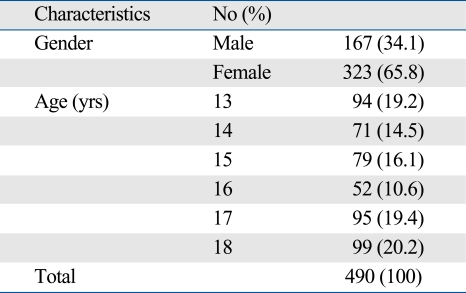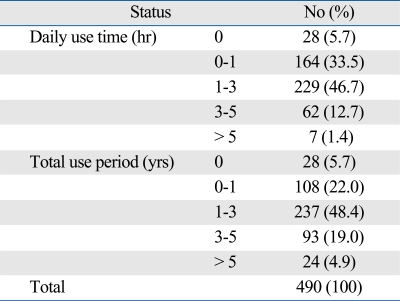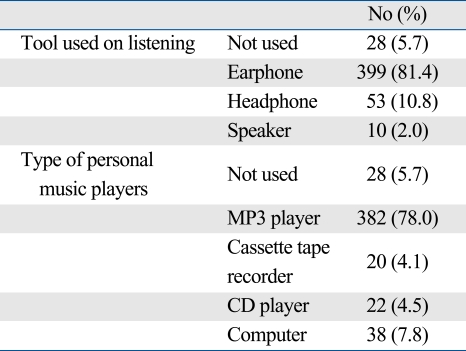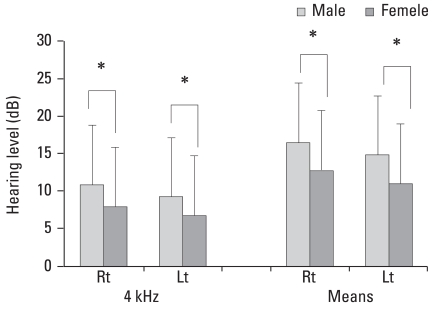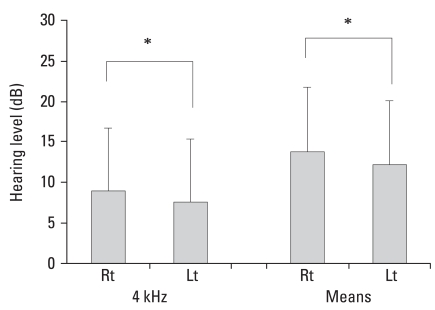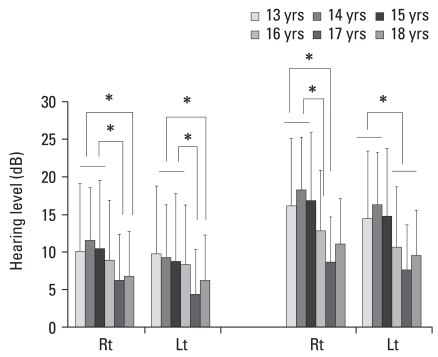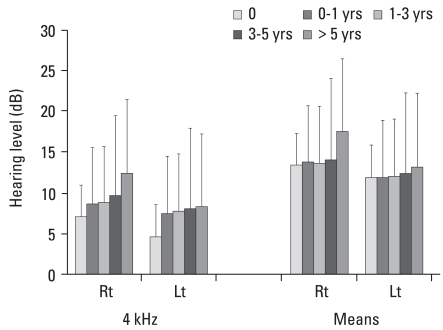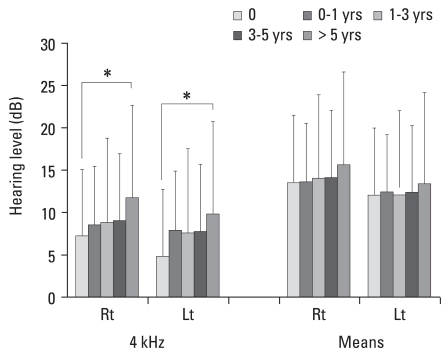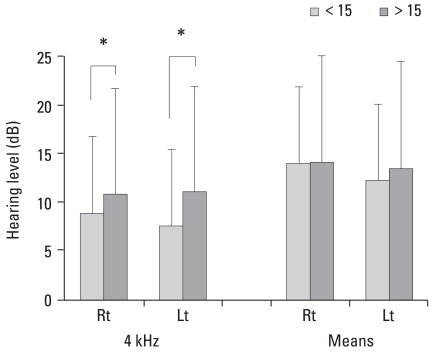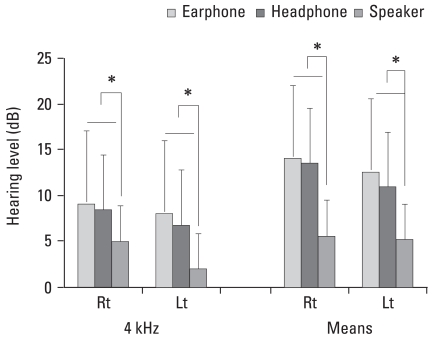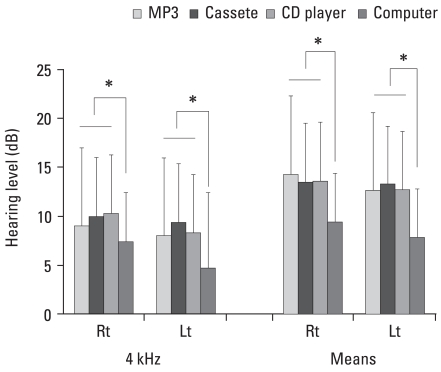Abstract
Purpose
Hearing loss can lead to a number of disabilities and can reduce quality of life. Noise-induced hearing losses have become more common among adolescents due to increased exposure to personal music players. We, therefore, investigated the use of personal music player among Korean adolescents and the relationship between hearing threshold and usage pattern of portable music players.
Materials and Methods
A total of 490 adolescents were interviewed personally regarding their use of portable music players, including the time and type of player and the type of headphone used. Pure tone audiometry was performed in each subject.
Results
Of the 490 subjects, 462 (94.3%) used personal music players and most of them have used the personal music player for 1-3 hours per day during 1-3 years. The most common type of portable music player was the MP3 player, and the most common type of headphone was the earphone (insert type). Significant elevations of hearing threshold were observed in males, in adolescents who had used portable music players for over 5 years, for those over 15 years in cumulative period and in those who had used earphones.
Conclusion
Portable music players can have a deleterious effect on hearing threshold in adolescents. To preserve hearing, adolescents should avoid using portable music players for long periods of time and should avoid using earphones.
Keywords: Hearing loss, adolescent
INTRODUCTION
Noise-induced hearing loss (NIHL) is a public health problem that can limit usual daily activities. Hearing loss can reduce physical and social execution behavior status and may induce psychological symptoms of anxiety and depression.1,2 Much effort has, therefore, been made to reduce the incidence of hearing loss in adults who are exposed to occupational noises. The incidence of NIHL has also been increasing in children and juveniles. For example, 40% of students between the ages of 16 and 25 years have audiological evidence of NIHL,3 and 1% of children attending school were reported to have symptoms of NIHL in 1996.4 More recently, 12.5% of students between the ages of 6 to 19 years were found to have noise-induced threshold shifts.5
NIHL in children and juveniles is related to noises produced during recreational and leisure activities. The noises produced by toys, band activities, motor sports and loud noises in concert halls and nightclubs have harmful effects on hearing.6,7 The use of personal music players can also cause noise-induced hearing loss in juveniles.7,8 Personal music players have very strong sound tones, and their maximum volume level can reach 78-136 dB.7 At present, most Korean students have personal music players, and they are widely used for listening to music and radio programs, and for studying foreign language programs, and it was thought that NIHL could occur in Korean adolescents. We, therefore, assessed the use of personal music player among middle and high school students and the relationship between hearing threshold and usage pattern of personal music players.
MATERIALS AND METHODS
Four hundred and ninety middle and high school students were randomly selected and recruited from hospitals in four regions (2 sites in Seoul city, Gyeongi-do and Masan city) of Korea between June 1 and July 31, 2007. Students were excluded if they had serous otitis media or perforation of the tympanic membrane, as determined by otoscopic examination; if they had hearing loss due to other previous diseases; tinnitus; previous or current history of otologic disorders; previous exposure to loud sounds produced by toys or guns; or previous exposure to loud noises in concert halls. After explaining the objectives of this study, we obtained written informed consent from each student, and the study protocol was approved by our Institutional Review Board.
Each student was asked to fill out a questionnaire, which included questions regarding daily use of personal music players, overall usage period, listening method and types of personal music players, along with questions regarding the gender and age of each student. The cumulative usage period was calculated by multiplying daily usage time by usage period.
Each subject underwent a pure tone audiometry examination (Virtual -320, USA), which was performed at a hearing level testing unit in a university hospital equipped with facilities recommended by the American National Standard Institute (ANSI S3.1-1999).9 For hearing measurements, a mixed method was used in order to minimize the effect of temporal threshold shifts and the learning effect. The signal intensity started at 30 dB and increased in 20 dB steps until the subject responded. The signal intensity was then increased in 5 dB steps until the subject responded. For each signal intensity, the procedure was repeated until the subject responded two of three times. Hearing was measured using a randomized presentation order for tonal frequencies. Hearing thresholds were expressed as the trisectional average hearing level using thresholds at the 500 Hz, 1 kHz and 2 kHz. Hearing thresholds were also measured at 4 kHz in all subjects.
For the statistical analysis of collected data, the hearing level threshold according to age, daily usage time, usage period, cumulative usage period, listening method, and type of personal music player was evaluated by multiple linear regression (SPSS 11.5). Independent Student's t-tests were used for analysis of the data by gender and comparison of hearing thresholds in the left and right ears (SPSS 11.5). Statistical significance was defined by p values less than 0.05.
RESULTS
Of the 490 selected subjects, 167 (34.1%) were males and 323 (65.8%) were females. Their age distribution is summarized in Table 1. Of the 490 students, 94 (19.2%) were 13 years-old, 71 (14.5%) were 14, 79 (16.1%) were 15, 52 (10.6%) were 16, 95 (19.4%) were 17, and 99 (20.2%) were 18 years old.
Table 1.
Distribution of the Subjects according to Gender and Age
Daily use of personal music players ranged from 1 to 3 hours in 229 students (46.7%). In addition, 164 students (33.5%) used these players for less than 1 hour per day, 62 (12.7%) used them 3 to 5 hours per day, 7 (1.4%) used them for more than 5 hours per day (1.4%), and 28 (5.7%) did not use personal music players (Table 2). The overall usage period of personal music players ranged from 1 to 3 years in 237 students (48.4%), less than 1 year in 108 (22.0%), 3 to 5 years in 93 (19.0%), and more than 5 years in 24 (4.9%) (Table 2).
Table 2.
Distribution of the Subjects according to Daily Use Time and Used Period of Personal Stereo System
We found that 399 students (81.4%) used mainly earphones (insert type), whereas only 53 (10.8%) used headphones (supra-aural type) and 10 (2.0%) used speakers. The most common type of personal music player was the MP3 player, used by 382 students (78.0%). In addition, 38 students (7.8%) used computers, 22 (4.5%) used CD players, and 20 (4.1%) used cassette tape players (Table 3).
Table 3.
Distribution of the Subjects according to Transducer and Type of Personal Music Players Used
In reviewing the results of hearing tests, we found that the means of hearing threshold and the hearing level at 4 kHz in male students were 16.4 ± 8.4 dB and 10.8 ± 8.7 dB, respectively, in the right ear, and 14.7 ± 8.3 dB and 9.2 ± 7.7 dB, respectively, in the left ear. The means and hearing level at 4 kHz in female students were 12.7 ± 8.0 dB and 7.9 ± 8.4 dB, respectively, in the right ear, and 11.0 ± 8.0 dB and 6.8 ± 7.7 dB, respectively, in the left ear. Male students had significantly higher hearing thresholds in both the left and right ears than female students (Fig. 1).
Fig. 1.
Hearing threshold at 4 kHz and means according to gender. *p<0.05.
In the subject population overall, the means and the hearing level at 4 kHz were 13.9 ± 8.3 dB and 8.9 ± 8.6 dB, respectively, in the right ear, both significantly higher than their respective levels, whereas 10.5 ± 5.7 dB and 7.6 ± 8.6 dB, in the left ear, respectively (Fig. 2). Hearing threshold level in both ears was significantly higher in students aged 13, 14, and 15 years than in students aged 17 and 18 years (Fig. 3).
Fig. 2.
Hearing threshold at 4 kHz and means according to side. *p<0.05.
Fig. 3.
Hearing threshold at 4 kHz and means according to age. *p<0.05.
Although there was no relationship between hearing threshold and daily use of portable music players (Fig. 4), we observed significant increases in students who had used these players for more than 5 years (11.7 ± 10.3 dB and 9.8 ± 12.8 dB at 4 kHz for the left and right ears, respectively) compared with students who did not use personal music players (7.2 ± 4.3 dB and 4.8 ± 4.7 dB, respectively) (Fig. 5). Hearing threshold at 4 kHz in the right and left ears was significantly higher in the 24 students with cumulative usage > 15 hr × years (11.7 ± 10.5 dB and 11.0 ± 14.6 dB, respectively) than in the 466 students with < 15 hr × years cumulative usage (8.7 ± 8.5 dB and 7.5 ± 7.5 dB, respectively; p < 0.05) (Fig. 6).
Fig. 4.
Hearing threshold at 4 kHz and means according to daily use time.
Fig. 5.
Hearing threshold at 4 kHz and means according to total use period. *p<0.05.
Fig. 6.
Hearing threshold at 4 kHz and means according to cumulative use period. *p<0.05.
Subjects listening to music using speakers were found to have means and hearing levels at 4 kHz in the left (5.6 ± 4.1 dB and 5.0 ± 6.0 dB, respectively) and right ears (5.2 ± 3.7 dB and 1.9 ± 2.6 dB, respectively) that were significantly lower than those of subjects of using earphones or headphones (Fig. 7). Subjects who used computers to listen to music were found to have satisfactory means and hearing levels at 4 kHz in the right (9.4 ± 7.5 dB and 7.4 ± 5.3 dB, respectively) and left ears (7.8 ± 6.1 dB and 4.7 ± 6.0 dB, respectively); these numbers were significantly different compared with subjects using other methods of listening to music (Fig. 8).
Fig. 7.
Hearing threshold at 4 kHz and means according to type of headphone. *p<0.05.
Fig. 8.
Hearing threshold at 4 kHz and means according to type of personal music player. *p<0.05.
DISCUSSION
Hearing loss is associated with difficulties in usual daily life. Children and adults with hearing loss may have limited social activities, have a reduced quality of life, or develop psychological problems, including feelings of isolation and exclusion, as well as depression and cognitive disorders.10 In approximately one-half of individuals with hearing loss problems, these losses are at least partially related to short term or chronic exposure to loud noises.11
Noise exposure is an important risk factor for hearing loss. Although exposure may be involuntary, many individuals are exposed voluntarily to noise, including people who listen to music using personal music players. The use of ear protection caps or the lowering of noise has been recommended for industrial workers who are exposed to an equivalent sound level (Leq) of > 85 dB of noises for 8 hours a day. But, typical listener has the volume at a range between 75-100 dB12 and individuals who listen to 15 minutes of music at 100 dB using personal music players may be exposed to the same level of loudness as industrial workers exposed to 85 dB in an 8 hour day.13 Thus, NIHL in juveniles may be caused by the use of personal music players.
The impact of exposure to noise on hearing level can be affected by various factors. For example, susceptibility to inner ear injury due to noise was found to depend on personal susceptibility factors, including differences between left and right ears and time of day, suggesting that inner ear injury may result from genetically variable responses to noise exposure.14 Indeed, we found that male students had significantly higher hearing thresholds than female students, and right ear hearing thresholds were significantly higher than left ear thresholds.
Although age was found to be an important risk factor associated with NIHL,14 the study was performed in subjects aged 65 years and older, and thus, is probably not related significantly to our study, which was performed in teenagers. We found that hearing threshold levels were higher in middle school students than in high school students. This difference may be associated with a relatively higher exposure of middle school students to noise at a younger age, due to recent introduction of new types of personal music players, including the MP3 player.
Although there was no significant association between hearing threshold and daily use of personal music players, we found that students who had used these players for more than 5 years and students showing cumulative usage times of 15 hr × years had significantly elevated hearing thresholds at 4 kHz. These findings indicate that cumulative long-term use of personal music players can have a debilitative effect on hearing levels.
Students who used speakers to listen to music had significantly lower hearing thresholds than those who used earphones and headphones. Furthermore, although not statistically significant, students using headphones had lower hearing thresholds than students using earphones. Earphones are smaller in size, more conveniently carried, and more comfortable to wear than headphones. Moreover, unlike speakers, earphones can be used in public places. Earphones are, therefore, preferred by most individuals; indeed, we found that 81.4% of the students surveyed used earphones. By blocking the external auditory canals, however, earphones can elevate output power by 7-9 dB compared with headphones that cover the entire external ears.15 In addition, more users of earphones than of speakers tend to elevate the sound volume to cope with environmental noises. Headphones may have effects similar to, but not greater than, those of earphones. These findings indicate that the use of earphones or headphone has a greater impact than the use of speakers in the development of hearing disorders. Hearing thresholds of juveniles who used MP3, cassette tape, and CD players were similar, whereas hearing thresholds of students who used computers were significantly lower. The superior hearing in the latter is likely due to their listening to music using speakers.
Chronic exposure to loud noise can cause noise-induced hearing loss by damaging hair cells in the organ of Corti. At birth, humans have about 16,000 hair cells in each ear, but damage to 30-50% of these cells can cause hearing level debilitation.16 Noise-induced hearing loss is irreversible in the absence of effective treatments, and hearing aids improve hearing levels only slightly, making the prevention of NIHL imperative.17 Hearing loss in juveniles can lead to many difficulties in future life, making the prevention of noise-induced hearing loss especially important in young people.
Studies have found that intake of vitamin and mineral rich foods, appropriate exercises, maintenance of clean oral hygiene and non-smoking are helpful in preventing the development of hearing loss.18-21 In juveniles, however, the prevention of NIHL has to include avoiding of loud noises produced during recreation and leisure activities, maintaining lower volumes when using personal music players in quiet places, avoiding long hours of personal music player use and not using earphones.
Although there was a limitation for the ratio of female and male in the subjects that were selected, we found in this study that most juveniles in Korea use personal music players, and that most listen to music using earphones. Most adolescents included in the present study had used these players for about 1-3 hours per day for 1-3 years. In this study, the outstanding point was that cumulative usage and the use of earphones or headphones had deleterious effects on hearing levels. Therefore, to conserve hearing level, juveniles should avoid continued long term use of personal music players and use speakers when listening to music.
In our study, types of earphones were unconsidered as the factor affecting NIHL. However, there are many type of earphones in the market, though almost all types of earphones are semi-insert type in Korea. Thus, further examination may be needed for the types of earphone.
Footnotes
The authors have no financial conflicts of interest.
References
- 1.Magilvy K. Quality of life of hearing-impaired older women. Nurs Res. 1985;34:140–144. [PubMed] [Google Scholar]
- 2.Mulrow CD, Aguilar C, Endicott JE, Tuley MR, Velez R, Charlip WS, et al. Quality-of-life changes and hearing impairment. A randomized trial. Ann Intern Med. 1990;113:188–194. doi: 10.7326/0003-4819-113-3-188. [DOI] [PubMed] [Google Scholar]
- 3.Lees RE, Roberts JH, Wald Z. Noise induced hearing loss and leisure activities of young people: a pilot study. Can J Public Health. 1985;76:171–173. [PubMed] [Google Scholar]
- 4.Blair JC, Hardegree D, Benson PV. Necessity and effectiveness of a hearing conservation program for elementary students. J Educ Audiol. 1996;4:12–16. [Google Scholar]
- 5.Niskar AS, Kieszak SM, Holmes AE, Esteban E, Rubin C, Brody DJ. Estimated prevalence of noise-induced hearing threshold shifts among children 6 to 19 years of age: the Third National Health and Nutrition Examination Survey, 1988-1994, United States. Pediatrics. 2001;108:40–43. doi: 10.1542/peds.108.1.40. [DOI] [PubMed] [Google Scholar]
- 6.Axelsson A, Jerson T. Noisy toys: a possible source of sensorineural hearing loss. Pediatrics. 1985;76:574–578. [PubMed] [Google Scholar]
- 7.Jokitulppo JS, Björk EA, Akaan-Penttilä E. Estimated leisure noise exposure and hearing symptoms in Finnish teenagers. Scand Audiol. 1997;26:257–262. doi: 10.3109/01050399709048017. [DOI] [PubMed] [Google Scholar]
- 8.Turunen-Rice I, Flottorp G, Tvete O. A study of the possibility of acquiring noise-induced hearing loss by the use of personal cassette players (walkman) Scand Audiol Suppl. 1991;34:133–144. [PubMed] [Google Scholar]
- 9.American National Standards Institute. Maximum Permissible Ambient Noise Levels for Audiometric Test Rooms. ANSI S3.1-1999. New York: American National Standards Institute; 1999. [Google Scholar]
- 10.Schmuzigert N, Fostiropoulos K, Probst R. Long-term assessment of auditory changes resulting from a single noise exposure associated with non-occupational activities. Int J Audiol. 2006;45:46–54. doi: 10.1080/14992020500377089. [DOI] [PubMed] [Google Scholar]
- 11.Centers for Disease Control and Prevention/NIOSH. Criteria for a Recommended Standard: Occupational Noise Exposure Revised Criteria. Cincinnati, Ohio: US Department of Health and Human Services; 1998. [Google Scholar]
- 12.Kageyama T. Loudness in listening to music with portable headphone stereos. Percept Mot Skills. 1999;88:423. doi: 10.2466/pms.1999.88.2.423. [DOI] [PubMed] [Google Scholar]
- 13.Daniel E. Noise and hearing loss: a review. J Sch Health. 2007;77:225–231. doi: 10.1111/j.1746-1561.2007.00197.x. [DOI] [PubMed] [Google Scholar]
- 14.Klein BE, Cruickshanks KJ, Nondahl DM, Klein R, Dalton DS. Cataract and hearing loss in a population-based study: the Beaver Dam Studies. Am J Ophthalmol. 2001;132:537–543. doi: 10.1016/s0002-9394(01)01126-6. [DOI] [PubMed] [Google Scholar]
- 15.Fligor BJ, Cox LC. Output levels of commercially available portable compact disc players and the potential risk to hearing. Ear Hear. 2004;25:513–527. doi: 10.1097/00003446-200412000-00001. [DOI] [PubMed] [Google Scholar]
- 16.Bronzaft A. The increase in noise pollution: what are the health effects? Nutr Health Rev. 1996;78:2–7. [Google Scholar]
- 17.Daniel E. Noise and hearing loss: a review. J Sch Health. 2007;77:225–231. doi: 10.1111/j.1746-1561.2007.00197.x. [DOI] [PubMed] [Google Scholar]
- 18.Kaygusuz I, Oztürk A, Ustündağ B, Yalçin S. Role of free oxygen radicals in noise-related hearing impairment. Hear Res. 2001;162:43–47. doi: 10.1016/s0378-5955(01)00365-3. [DOI] [PubMed] [Google Scholar]
- 19.Kolkhorst FW, Smaldino JJ, Wolf SC, Battani LR, Plakke BL, Huddleston S, et al. Influence of fitness on susceptibility to noise-induced temporary threshold shift. Med Sci Sports Exerc. 1998;30:289–293. doi: 10.1097/00005768-199802000-00018. [DOI] [PubMed] [Google Scholar]
- 20.Lawrence HP, Garcia RI, Essick GK, Hawkins R, Krall EA, Spiro A, 3rd, et al. A longitudinal study of the association between tooth loss and age-related hearing loss. Spec Care Dentist. 2001;21:129–140. doi: 10.1111/j.1754-4505.2001.tb00242.x. [DOI] [PubMed] [Google Scholar]
- 21.Ferrite S, Santana V. Joint effects of smoking, noise exposure and age on hearing loss. Occup Med (Lond) 2005;55:48–53. doi: 10.1093/occmed/kqi002. [DOI] [PubMed] [Google Scholar]



